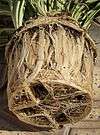Container garden

Container gardening or pot gardening is the practice of growing plants, including edible plants, exclusively in containers instead of planting them in the ground.[1]
A container is the general term used in gardening for a small, enclosed and usually portable object used for displaying live flowers or plants. It may take the form of a pot, box, tub, pot, basket, tin, barrel or hanging basket.
Pots, traditionally made of terracotta but now more commonly plastic, and window boxes have been the most commonly seen. Small pots are commonly called flowerpots.[2] In some cases, this method of growing is used for ornamental purposes. This method is also useful in areas where the soil or climate is unsuitable for the plant or crop in question. Using a container is also generally necessary for houseplants. Limited growing space, or growing space that is paved over, can also make this option appealing to the gardener.[2]
Planting
Containers range from simple plastic pots, teacups to complex automatic-watering irrigation systems. This flexibility in design is another reason container gardening is popular with growers. They can be found on porches, front steps, and in urban locations, on rooftops. Sub-irrigated planters (SIP) are a type of container that may be used in container gardens.[3][4] Potting material must be loose and allow drainage to offer proper aeration for roots to breathe, preventing root rot.
Re-potting

Re-potting is the action of placing an already potted plant into a larger or smaller pot. A pot that fits a plant's root system better is normally used. Plants are usually re-potted according to the size of their root system. Most plants need to be re-potted every few years, because they become "pot-bound" or "root-bound." Plants' roots can sense its surroundings, including the size of the pot it is in, and increasing the pot size allows plant size to increase proportionally.[5]
Advantages
Many types of plants are suitable for the container, including decorative flowers, herbs, cacti, vegetables, and small trees.[3][6] There are many advantages to growing plants in containers, namely:
- Less risk of soil-borne disease
- Virtually eliminate weed problems
- Mobile plants gives more control over moisture, sunlight & temperature
Pot farming
Crops can be grown in flowerpots[7] and it is called pot farming or pot agriculture.
See also
References
- ↑ Mills, Linn (29 January 2012). "Reap Benefits Of Container Gardening". Las Vegas Review Journal. Retrieved 1 January 2013.
- 1 2 "Welcome To The World Of Container Gardening". University of Illinois. Retrieved 1 January 2013.
- 1 2 Thompson, Al (18 December 2012). "Container Gardening Offers Many Benefits". Santa Maria Times. Retrieved 1 January 2013.
- ↑ Note: SIP simply means watering from below, in large commercial applications it would not be strictly a container garden.
- ↑ Society for Experimental Biology (1 July 2012). "Want bigger plants? Get to the root of the matter". (e) Science News. Retrieved 18 July 2014.
- ↑ "The 35 Easiest Container and Pot Friendly Fruits, Vegetables and Herbs". DIY & Crafts. Retrieved 17 July 2014.
- ↑ Flowerpot Farming: Creating your own Urban Kitchen Garden
External links
| |||||||||||||||||||||||||||||
